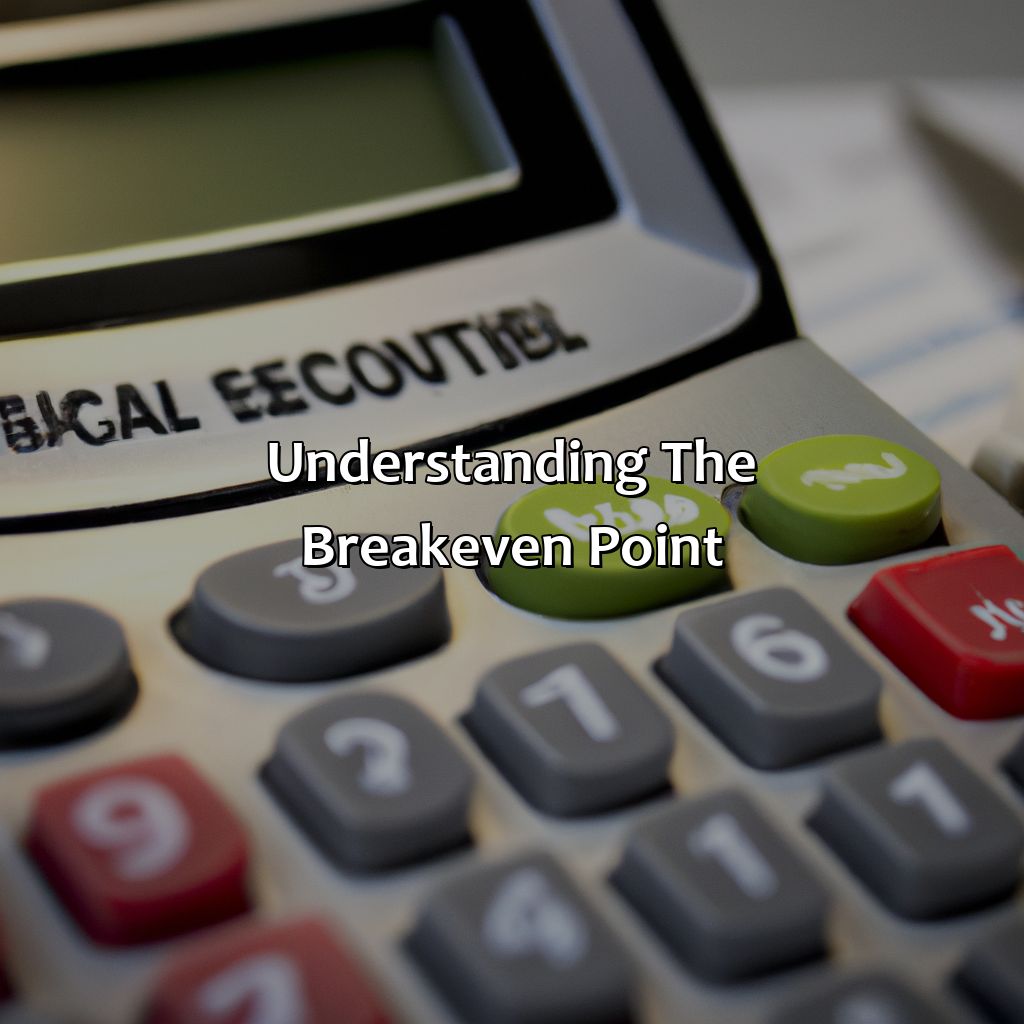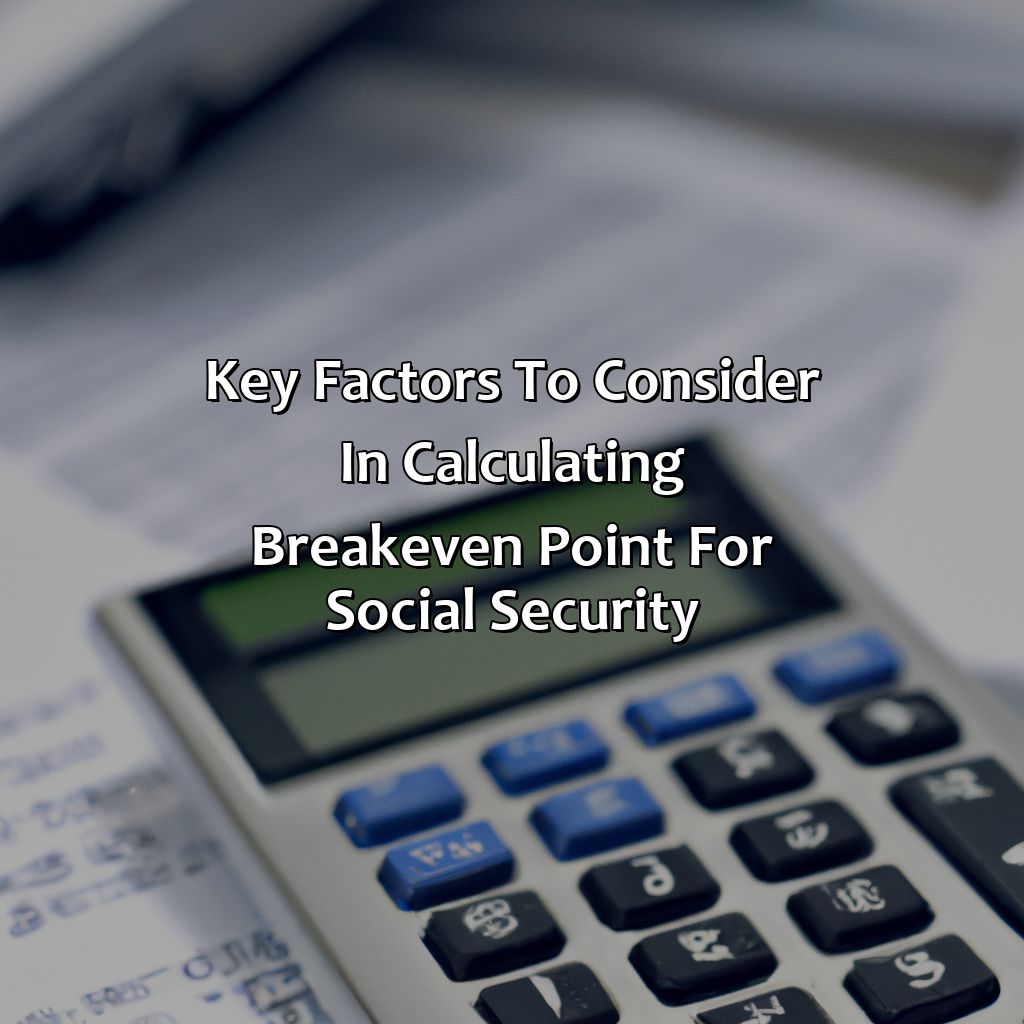How To Calculate The Break Even Point For Social Security?
Key Takeaway:
- Understanding the break-even point: The break-even point is the age at which the total amount of Social Security benefits received equals the total amount of benefits that would have been received had you delayed receiving benefits. It is important to calculate your break-even point to determine whether it makes financial sense to claim Social Security benefits early or delay them.
- Key factors to consider: To accurately calculate your break-even point, you need to consider three key factors: your average indexed monthly earnings (AIME), your primary insurance amount (PIA), and your full retirement age (FRA). These factors determine how much you will receive in Social Security benefits and how your benefits will be impacted if you claim early or delay.
- Steps to calculate: To calculate your break-even point, you need to follow four steps. First, determine your AIME. Second, calculate your PIA. Third, decide when to claim Social Security based on your financial situation and goals. Fourth, find the break-even age by comparing the total benefits received at different claiming ages.
Are you worried about how to cover your living costs in retirement? Calculating a break-even point for social security can help you gain financial security and peace of mind. You’ll learn the steps to take in this article.
Understanding the Break-Even Point
The break-even point calculation refers to the age at which total Social Security benefits received equals the total amount of benefits that would have been collected if the recipient opted for a later claiming age. Understanding the break-even point is crucial when deciding the right time to begin collecting benefits.
To calculate the break-even point, one needs to consider their full retirement age (FRA) and the age at which they begin collecting benefits. Retiring before FRA results in a permanent reduction in benefits, while delaying benefits past FRA results in an increase. These factors must be balanced against life expectancy to determine the break-even point.
It’s important to note that the break-even point is not a guarantee of any particular amount of benefits received. It simply shows the ages and benefits that result in equal total payments. It’s advisable to consult a financial advisor to make an informed decision based on individual needs and circumstances.
John was 62 years old when he decided to begin receiving Social Security benefits. His FRA was 66, and he would have received $1,000 per month if he waited to retire at FRA. Instead, he opted to start receiving benefits early, which resulted in a 25% reduction to $750 per month. Based on John’s life expectancy, he would break even at 78 years old, meaning he would receive the same total benefits regardless of when he began collecting them.

Image credits: retiregenz.com by James Woodhock
Key Factors to Consider in Calculating Break-Even Point for Social Security
Calculating the break-even point for social security? Consider key factors like AIME, PIA, and FRA. They all play a major role. We will explore how they affect your decisions. Each factor is important in figuring out the best time to begin social security benefits.

Image credits: retiregenz.com by Yuval Jones
Average indexed monthly earnings (AIME)
The Average Monthly Earnings (AME) is a crucial determinant in calculating your Social Security benefits. This number is calculated by averaging your top 35 years of earnings and then indexing them to account for inflation. The resulting number is called the Average Indexed Monthly Earnings (AIME). The higher your AIME, the higher your Social Security benefit will be.
That being said, it’s important to note that not all earnings are included in this calculation. Only earnings on which you paid Social Security taxes are counted towards your AME, meaning any income earned from tax-exempt sources like municipal bonds or rental properties will not be factored in.
It’s important to keep track of your earnings history as errors can easily occur, and incorrect information can lead to a lower benefit amount. Periodically reviewing your earnings statement ensures you’re receiving the maximum benefit amount you’re entitled to under the law.
In the past, before automatic record-keeping existed, there were cases where individuals lost track of their earnings due to natural disasters destroying personal records or misplaced documents leading to unintended under-reporting of earned income. Thankfully, today’s technology has made it easier for individuals to access and review their earning statements online.
If only our social lives had a PIA that could be calculated as easily as our Social Security benefits.
Primary insurance amount (PIA)
The primary amount received monthly by a social security beneficiary is the basis for deciding on the payout. PIA is derived based on one’s lifetime earnings, which are adjusted for inflation to determine its present value. The PIA is then calculated using a fixed percentage of one’s average indexed monthly earnings (AIME) within certain limits.
This calculation varies depending on the year in which one will turn 62 years old and begin receiving benefits. Additionally, factors such as income level, marital status, length of marriage and employment history may affect how much an individual receives from Social Security benefits.
It should be noted that calculating PIA is just one aspect of determining break-even points for Social Security benefits. It’s important to factor in other considerations like cost-of-living-adjustments, taxes paid on benefits and health care costs during retirement planning.
Pro Tip: Consider consulting with a financial advisor or professional before making any significant decisions regarding Social Security to fully understand all the options available.
If time is money, then hitting full retirement age is like hitting the jackpot for your Social Security benefits.
Full retirement age (FRA)
The age at which an individual can claim maximum social security benefits is significant in calculating the break-even point. This age is known as the primary insurance amount (PIA).
To find the full retirement age, you need to take birth year into account as it differs for individuals born before 1960 or after. For those born before 1960, FRA starts at 66 years while for those born between 1960-67, FRA gradually increases.
Once you determine your full retirement age, you can plan for claiming social security benefits accordingly. Claiming earlier will result in reduced benefit amounts, and delaying claiming beyond FRA will increase benefits.
It’s essential to understand that claiming early or late will not affect the total payout received over a lifetime; the Social Security program ensures both options have equal payouts over time.
Pro Tip – It’s wise to wait until FRA or even delay up to the age of 70 if possible as waiting can result in more substantial monthly payments and better financial stability in retirement.
Let’s calculate that break-even point for social security and hope it’s not the equivalent of finding a needle in a haystack.
Steps to Calculate Break-Even Point for Social Security
Calculate the break-even point for social security! There are 4 steps:
- First, find your AIME.
- Second, calculate your PIA.
- Third, decide when to claim social security.
- Finally, figure out the break-even age.
These 4 steps will help you reach a break-even point with your social security benefits and get the most out of them!

Image credits: retiregenz.com by Adam Washington
Step 1: Determine Your AIME
Determining Your Average Indexed Monthly Earnings (AIME) is an essential step in calculating the break-even point for Social Security benefits.
To determine your AIME:
- Collect all the earning records from your Social Security statement.
- Choose the highest-paid 35 years in terms of employment earnings and add them up.
- Divide this total by 420, which corresponds to 35 years multiplied by a year’s worth of monthly payments (12).
- Round down to the nearest cent.
It is imperative to note that some earnings might not be counted towards Social Security contribution, like pensions from employers who didn’t pay into Social Security.
When calculating your AIME, some nuances may occur. For instance, if you work below 35 years, missing years are included as zeros, lowering your average wage. Moreover, those with lower annual wages than others face higher weight on their Social Security payments while not including any job-related income over $147,414 each year.
According to SSA guidelines, individuals born after January 2,1955 and planning on retiring in the next ten years must factor Social Security’s estimated benefit amount using their AIMEs.
“Social security benefits help reduce poverty rates among seniors,” according to Data.usa.gov.
Finally, some math that actually matters: calculating your PIA for social security.
Step 2: Calculate Your PIA
To determine your Primary Insurance Amount (PIA), which is a crucial factor in calculating the Break-Even Point for Social Security, follow the instructions below:
- Access your earnings history by logging into your Social Security account online or by requesting a statement from the SSA.
- Identify your highest-earning year(s) and record the amount(s).
- The PIA formula uses detailed calculations, including primary insurance factors and bend points. Use an online calculator or talk to a financial advisor to get an accurate PIA calculation.
- You can begin claiming benefits at age 62, but you will receive reduced benefits. Delaying benefits until age 70 will increase your PIA, but it may not be worth waiting that long depending on various factors such as life expectancy, retirement plans, etc.
- Once you have obtained your PIA amount, this will be used to calculate other important figures like breakpoints and incentives.
It’s important to note that calculating your PIA can be complex and time-consuming; therefore, consulting with a financial advisor or using an online calculator is recommended.
Pro Tip: The longer you delay filing for social security retirement benefits after reaching age 62 until age 70, the higher monthly payments are. Deciding when to claim Social Security is like choosing between a slice of cake now or a whole cake later, except the cake might run out before you get a chance to indulge.
Step 3: Decide When to Claim Social Security
Determining the optimal time to claim social security is a significant decision that impacts your lifetime benefits. Finding out when you should apply for social security and begin taking payments could result in thousands of dollars extra throughout your lifetime.
Here’s a Five-Step Guide on deciding when to claim social security:
- Understand the Eligibility Age
- Consider Your Life Expectancy
- Recognize Tax Consequences
- Evaluate Investment Returns
- Take into Account Spousal Benefits
To make the appropriate decision, consider factors like tax purposes, financial implications and income sources before claiming Social Security retirement benefits. Pro Tip: Use online retirement calculators or an experienced financial advisor to evaluate your estimated monthly payments based on the time you decide to commence taking social security benefits. Find your break-even age, or just keep working till you drop dead- either way, the social security system wins.
Step 4: Find the Break-Even Age
To determine the point at which Social Security benefits break even with earlier claiming, one must calculate the break-even age.
Here is a brief guide to finding the break-even age:
- Calculate the difference between the monthly benefit amounts for two different ages.
- Divide that difference by the expected annual increase in benefit amounts due to delayed retirement credits.
- Rounded up to the nearest whole number, this result represents the age at which an individual’s cumulative benefits are equal, regardless of whether they claiming their benefit early or later than full retirement age.
It is important to note that any assumptions made about life expectancy or future changes to Social Security policy may affect this calculation.
A pro tip to keep in mind is that while calculating your break-even age can be informative, there are many other factors to consider when deciding on an ideal time to claim Social Security benefits. It may be beneficial to speak with a financial advisor before making any decisions.
Some Facts About How to Calculate the Break Even Point for Social Security:
The break-even point for Social Security is the age at which you would receive the same total lifetime benefits regardless of when you start taking Social Security. (Source: SSA.gov)
You can use an online calculator to estimate your break-even age based on your earnings history. (Source: AARP.org)
The break-even age varies depending on your individual earnings history and life expectancy. (Source: The Motley Fool)
Delaying your Social Security benefits can increase your monthly payments and potentially push your break-even age to a later age. (Source: CNBC.com)
Taking Social Security early may be advantageous for those with health issues or a shorter life expectancy, as they may receive more total benefits over their lifetime. (Source: Investopedia)
FAQs about How To Calculate The Break Even Point For Social Security?
How to Calculate the Break Even Point for Social Security?
Calculating the break-even point for Social Security is an essential task for individuals who want to plan their retirement effectively. The break-even point for Social Security is the point at which the total cumulative benefits received from Social Security equal the total amount of contributions made over a lifetime. Below are six frequently asked questions with answers, which should help you calculate the break-even point for Social Security.
What Are the Factors to Consider When Calculating the Break Even Point for Social Security?
The factors to consider when calculating the break-even point for Social Security include your life expectancy, your Social Security benefits, and your average annual income. These variables are used to determine the total amount of benefits you can expect to receive over the course of your lifetime and how long it takes for these benefits to equal the total amount of contributions made to Social Security.
How Do I Calculate My Social Security Benefits?
You can use the Social Security Administration’s Benefits Calculator to determine your Social Security benefits. This calculator takes into account your age, earnings history, and other important factors to estimate your monthly benefit amount.
What Is the Average Age to Receive Social Security Benefits?
The average age to receive Social Security benefits is 66 years and two months. However, you can begin receiving benefits as early as age 62 or as late as age 70. The amount of your benefits will vary depending on when you begin receiving benefits.
What Happens to My Social Security Benefits If I Pass Away Before Receiving Them?
If you pass away before receiving Social Security benefits, your spouse or child may be eligible to receive survivor benefits. The amount of survivor benefits depends on various factors, including your work history and the age of your surviving spouse or child.
Can I Work and Collect Social Security Benefits?
Yes, you can work and collect Social Security benefits at the same time. However, if you are under full retirement age, your benefits may be reduced if you earn above a certain amount. You should consult a financial advisor to determine the best strategy for collecting Social Security benefits while still working.
 Checkout this IRS Loophole
Checkout this IRS Loophole 
